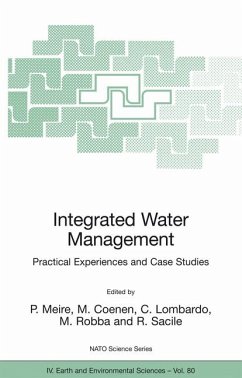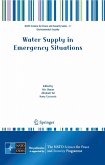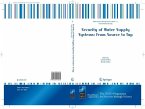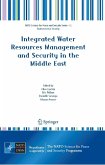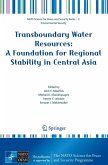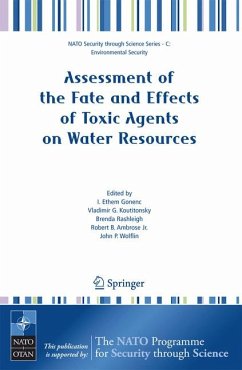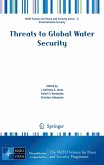Integrated Water Management (eBook, PDF)
Practical Experiences and Case Studies
Redaktion: Meire, P.; Sacile, R.; Robba, M.; Lombardo, C.; Coenen, M.
233,95 €
233,95 €
inkl. MwSt.
Sofort per Download lieferbar

117 °P sammeln
233,95 €
Als Download kaufen

233,95 €
inkl. MwSt.
Sofort per Download lieferbar

117 °P sammeln
Jetzt verschenken
Alle Infos zum eBook verschenken
233,95 €
inkl. MwSt.
Sofort per Download lieferbar
Alle Infos zum eBook verschenken

117 °P sammeln
Integrated Water Management (eBook, PDF)
Practical Experiences and Case Studies
Redaktion: Meire, P.; Sacile, R.; Robba, M.; Lombardo, C.; Coenen, M.
- Format: PDF
- Merkliste
- Auf die Merkliste
- Bewerten Bewerten
- Teilen
- Produkt teilen
- Produkterinnerung
- Produkterinnerung

Bitte loggen Sie sich zunächst in Ihr Kundenkonto ein oder registrieren Sie sich bei
bücher.de, um das eBook-Abo tolino select nutzen zu können.
Hier können Sie sich einloggen
Hier können Sie sich einloggen
Sie sind bereits eingeloggt. Klicken Sie auf 2. tolino select Abo, um fortzufahren.

Bitte loggen Sie sich zunächst in Ihr Kundenkonto ein oder registrieren Sie sich bei bücher.de, um das eBook-Abo tolino select nutzen zu können.
Integrated Water Management (IWM) deals with the planning and management of water resources by integrating the different issues involved, including ecological, economic, technical legislative, and transboundary. This book offers a general framework for IWM. It includes both the different environmental problems that affect the very different ecosystems and the main methodologies able to face the problem of IWM.
- Geräte: PC
- ohne Kopierschutz
- eBook Hilfe
- Größe: 19.48MB
Andere Kunden interessierten sich auch für
![Water Supply in Emergency Situations (eBook, PDF) Water Supply in Emergency Situations (eBook, PDF)]() Water Supply in Emergency Situations (eBook, PDF)161,95 €
Water Supply in Emergency Situations (eBook, PDF)161,95 €![Security of Water Supply Systems: from Source to Tap (eBook, PDF) Security of Water Supply Systems: from Source to Tap (eBook, PDF)]() Security of Water Supply Systems: from Source to Tap (eBook, PDF)161,95 €
Security of Water Supply Systems: from Source to Tap (eBook, PDF)161,95 €![Integrated Water Resources Management and Security in the Middle East (eBook, PDF) Integrated Water Resources Management and Security in the Middle East (eBook, PDF)]() Integrated Water Resources Management and Security in the Middle East (eBook, PDF)161,95 €
Integrated Water Resources Management and Security in the Middle East (eBook, PDF)161,95 €![Transboundary Water Resources: A Foundation for Regional Stability in Central Asia (eBook, PDF) Transboundary Water Resources: A Foundation for Regional Stability in Central Asia (eBook, PDF)]() Transboundary Water Resources: A Foundation for Regional Stability in Central Asia (eBook, PDF)161,95 €
Transboundary Water Resources: A Foundation for Regional Stability in Central Asia (eBook, PDF)161,95 €![Assessment of the Fate and Effects of Toxic Agents on Water Resources (eBook, PDF) Assessment of the Fate and Effects of Toxic Agents on Water Resources (eBook, PDF)]() Assessment of the Fate and Effects of Toxic Agents on Water Resources (eBook, PDF)258,95 €
Assessment of the Fate and Effects of Toxic Agents on Water Resources (eBook, PDF)258,95 €![Threats to Global Water Security (eBook, PDF) Threats to Global Water Security (eBook, PDF)]() Threats to Global Water Security (eBook, PDF)113,95 €
Threats to Global Water Security (eBook, PDF)113,95 €![Overexploitation and Contamination of Shared Groundwater Resources (eBook, PDF) Overexploitation and Contamination of Shared Groundwater Resources (eBook, PDF)]() Overexploitation and Contamination of Shared Groundwater Resources (eBook, PDF)161,95 €
Overexploitation and Contamination of Shared Groundwater Resources (eBook, PDF)161,95 €-
-
-
Integrated Water Management (IWM) deals with the planning and management of water resources by integrating the different issues involved, including ecological, economic, technical legislative, and transboundary. This book offers a general framework for IWM. It includes both the different environmental problems that affect the very different ecosystems and the main methodologies able to face the problem of IWM.
Dieser Download kann aus rechtlichen Gründen nur mit Rechnungsadresse in A, B, BG, CY, CZ, D, DK, EW, E, FIN, F, GR, HR, H, IRL, I, LT, L, LR, M, NL, PL, P, R, S, SLO, SK ausgeliefert werden.
Produktdetails
- Produktdetails
- Verlag: Springer Netherlands
- Seitenzahl: 363
- Erscheinungstermin: 7. November 2007
- Englisch
- ISBN-13: 9781402065521
- Artikelnr.: 37347369
- Verlag: Springer Netherlands
- Seitenzahl: 363
- Erscheinungstermin: 7. November 2007
- Englisch
- ISBN-13: 9781402065521
- Artikelnr.: 37347369
- Herstellerkennzeichnung Die Herstellerinformationen sind derzeit nicht verfügbar.
Concepts and Approaches of Integrated Water Management.- Filling the Information Gap between Water Systems and Decision Makers in the Sustainable Development of a Territory.- Towards an Adaptive Approach in Planning and Management Process.- The Value of the Italian Civil Protection System in Integrated Water Management For The Mediterranean Environment.- Knowledge Discovery in Environmental Data.- NetSyMoD - An Integrated Approach for Water Resources Management.- Water Conflicts: An Unavoidable Challenge from the Transboundary to the Local Dimension.- Case Studies.- An Eco-Hydrological Project on Turkey Creek Watershed, South Carolina, U.S.A.- Integrated Transboundary Management of Lake Constance Driven by the International Commission for the Protection of Lake Constance (IGKB).- Integrated Water Mangement in the Seven Cities Basin.- Establishment of the Iskar Reservoir Minimum Sanitary Storage Capacity.- Eutrophication in the Blackwater River Catchment, Ireland.- The Proposal of IWRM in the Bouregreg Basin and How it Fits with the UNESCO/HELP Policy Program.- Impact of the Ignalina Nuclear Power Plant on the Druksiai Cooler - Lake.- Transboundary River Contract Semois-Semoy Between Belgium (Wallonia) and France.- Ground and Water Levels Change in the Scheldt Basin.- The Architecture of a Decision Support System (DSS) for Groundwater Quality Preservation in Terceira Island (Azores).- Greece: Ecosystem Based IWM Plans in the Framework of WFD Implementation: The "Strymon" Pilot Project.- The Role of the Help Programme.- Participation Aspects in the Realisation of the Nete River Basin Management Plan: Methodology and Application.- The Use of Hydrological Characteristics for Wetland Habitats Protection in Water Management of the Upper Narew River System.- SaltwaterIntrusion in a Unconfined Coastal Aquifer: The Case Study of Cervia (North Adriatic Sea, Italy).- International and Inner Transboundary River Basins in the Kaliningrad Oblast, South-Eastern Baltic.- Reports of the Working Groups.- Environmental Indicators for Water Resources Management.- Developments in Participation within Integrated Water Management.- Conclusion.
Concepts and Approaches of Integrated Water Management.- Filling the Information Gap between Water Systems and Decision Makers in the Sustainable Development of a Territory.- Towards an Adaptive Approach in Planning and Management Process.- The Value of the Italian Civil Protection System in Integrated Water Management For The Mediterranean Environment.- Knowledge Discovery in Environmental Data.- NetSyMoD - An Integrated Approach for Water Resources Management.- Water Conflicts: An Unavoidable Challenge from the Transboundary to the Local Dimension.- Case Studies.- An Eco-Hydrological Project on Turkey Creek Watershed, South Carolina, U.S.A.- Integrated Transboundary Management of Lake Constance Driven by the International Commission for the Protection of Lake Constance (IGKB).- Integrated Water Mangement in the Seven Cities Basin.- Establishment of the Iskar Reservoir Minimum Sanitary Storage Capacity.- Eutrophication in the Blackwater River Catchment, Ireland.- The Proposal of IWRM in the Bouregreg Basin and How it Fits with the UNESCO/HELP Policy Program.- Impact of the Ignalina Nuclear Power Plant on the Druksiai Cooler - Lake.- Transboundary River Contract Semois-Semoy Between Belgium (Wallonia) and France.- Ground and Water Levels Change in the Scheldt Basin.- The Architecture of a Decision Support System (DSS) for Groundwater Quality Preservation in Terceira Island (Azores).- Greece: Ecosystem Based IWM Plans in the Framework of WFD Implementation: The "Strymon" Pilot Project.- The Role of the Help Programme.- Participation Aspects in the Realisation of the Nete River Basin Management Plan: Methodology and Application.- The Use of Hydrological Characteristics for Wetland Habitats Protection in Water Management of the Upper Narew River System.- SaltwaterIntrusion in a Unconfined Coastal Aquifer: The Case Study of Cervia (North Adriatic Sea, Italy).- International and Inner Transboundary River Basins in the Kaliningrad Oblast, South-Eastern Baltic.- Reports of the Working Groups.- Environmental Indicators for Water Resources Management.- Developments in Participation within Integrated Water Management.- Conclusion.
